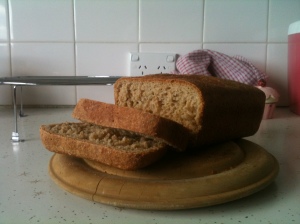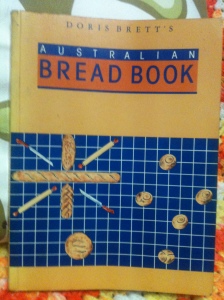First, a disclaimer.
This is not a cooking blog. There are too many of them as is, and, as previous misadventures demonstrate, I do not possess the culinary chops to hitch my wagon to that particular horse.
But it does involve bread, good food writing and schoolmistress copperplate.
Let’s go back a few days. Last Thursday I received a parcel from my grandmother, containing a beautifully written note and Doris Brett’s Australian Bread Book. I was delighted to hear that you are into bread making, the note read. This was news to me. I think I became briefly enamoured with the idea while reading Nigella Lawson’s thoughts on the subject, but that woman makes everything sound seductive. I wasn’t aware I’d disclosed this urge to anyone else.
I love the idea of bread-making in the same way I love the idea of living from produce grown in the home garden and pre-soaking chickpeas to make hummus – it’s a rosy ideal never to be fulfilled. But my grandmother is nothing if not an eminently sensible master of household skills, and it was her book, so I was prepared to give it a go.
It is a common mistake when selecting cookbooks to gravitate toward those with the highest quantity of high-gloss photographs. We flick through them like magazines and, like magazines, discard them after two days and never turn a page again. What a cookbook really needs is great writing. Doris has this in spades.
Her introduction reads:
“Over the years breadmaking has achieved a skilful publicity trick. Everyone has been seduced into believing that it is a difficult and painstaking art (comparable to silencing encyclopaedia salespeople at 70 paces, or something like that).
For those of us in the know, this makes life very pleasant. Production of a loaf of homemade bread is usually greeted with ecstatic cries of – `Ohh, you are clever!’, `How do you do it?’, `Marry me’. As far as I can tell, cookery books tend to propagate this myth by craftily giving misleading instructions. And as we have been taught to believe that the printed word equals the truth, most of us attempt these recipes, fail miserably, throw the bread at the nearest cat or handy receptacle, and decide that breadmaking is not for us – it is just too difficult…’’
I read the book cover to cover. I learned that “Yeasts are the martyrs of the breadmaking world’’ and “luckily, bread is much more controllable than teenage children’’. It was like having a learned aunty in the kitchen, clothed in sensible flour-dusted gingham and naughty in that well-married way. And you know what? The bread worked. It was really quite easy. Look, I took a picture:

My grandmother first came across Doris as a textbook in a breadmaking class at Mudgee TAFE. I can see why it was so favoured. Even her section for explaining common baking mistakes calls to mind a kindly friend pouring a glass of wine and telling you to Keep Calm and Carry On. After first explaining that no-one who has read the rest of her book will need the chapter on What To Do In Case Of Cock-Ups, but may use it to dish out advice to their less-informed friends, she suggests this course of action:
“You can look wise, excuse yourself for a minute, check up in this section and return with a gracious, if not slightly condescending, explanation of what went wrong.’’
So I think I’ll be making bread again. And it’s not just because I now have the appropriate tin and half a tonne of flour, or because yeast only comes in packets of 12. It’s because I want to read Doris, learn from Doris and come to rely on her as an old friend. Just as my grandmother does.

